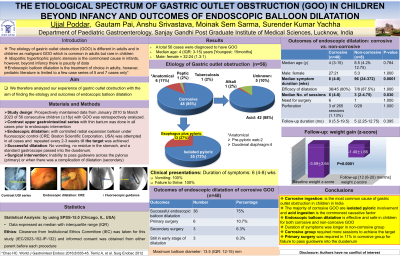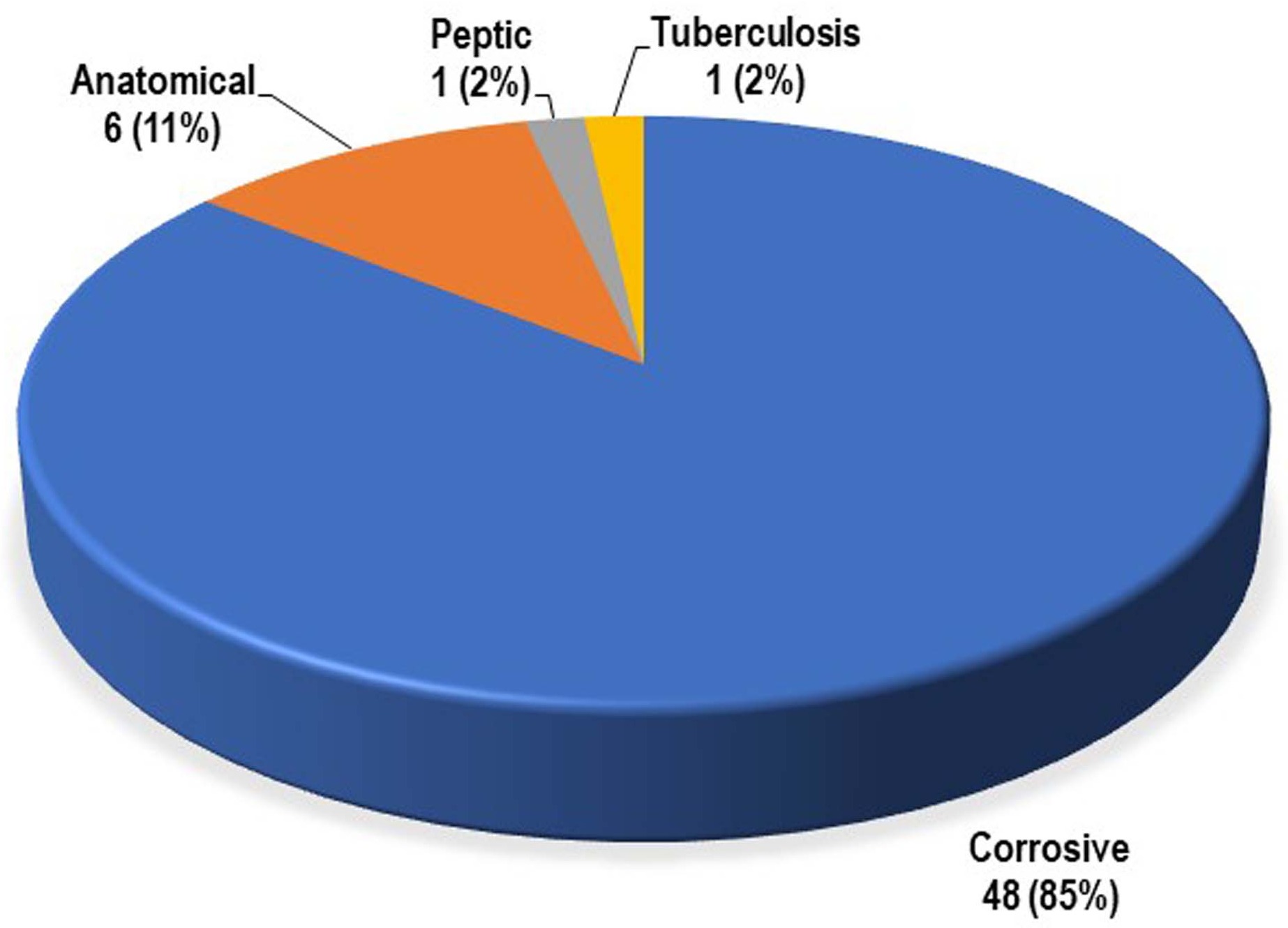Sunday Poster Session
Category: Pediatrics
P1175 - The Etiological Spectrum of Gastric Outlet Obstruction in Children Beyond Infancy and Outcomes of Endoscopic Balloon Dilatation
Sunday, October 22, 2023
3:30 PM - 7:00 PM PT
Location: Exhibit Hall

Has Audio
.jpg)
Ujjal Poddar, MD
Sanjay Gandhi Postgraduate Institute of Medical Sciences
Lucknow, Uttar Pradesh, India
Presenting Author(s)
Ujjal Poddar, MD, Gautam Pai, MD, Anshu Srivastava, MD, Moinak Sen Sarma, MD, Surender K Yachha, MD
Sanjay Gandhi Postgraduate Institute of Medical Sciences, Lucknow, Uttar Pradesh, India
Introduction: The etiology of gastric outlet obstruction (GOO) is different in children than in adults as malignant GOO, is rare in children. Idiopathic hypertrophic pyloric stenosis is the commonest cause in infants, however, beyond infancy, there is a paucity of published data on the etiology of GOO. Endoscopic balloon dilatation is the treatment of choice in adults but pediatric literature is limited to a few case series only. Hence, we analyzed our experience of gastric outlet obstruction with the aim to find the etiology and outcome of endoscopic dilatation.
Methods: The prospectively kept database of children with GOO from January 2010 to April 2023, was analyzed retrospectively. Their clinical details and endoscopic outcomes were retrieved from the endoscopic and electronic databases. Endoscopic dilatation with controlled radial expansion balloon under fluoroscopic control (CRE balloon, Boston Scientific Corporation, USA) was attempted in all. Data expressed as the median and interquartile range (IQR).
Results: A total of 56 children with a median age of 4 years (IQR: 3-15) were managed during the study period. The male-to-female ratio was 32:24. The etiology includes corrosive 48 (86%) [acid in 42 (87.5%), alkali in 1 and unknown 5], anatomical causes (congenital web/diaphragm) 6 (11%), peptic 1 (1.8%), and tuberculosis 1 (1.8%) (Figure 1). Among the corrosive GOO, 35 of 48 (73%) were isolated pyloric stenosis and 13 (27%) had both esophagus and stomach involvement. All of them presented with vomiting and failure to thrive. Endoscopic dilatation was successful in 44 (78.6%), primary surgery was required in 5 (9%) as guide wire could not be negotiated in them, secondary surgery (following perforation) in 4 (7%), and 3 (5.4%) are still on the early stage of the dilatation program. The median number of dilatation sessions required to make the patient asymptomatic was 6 (IQR, 4 - 8) and the median balloon diameter was 13.5 mm (IQR: 12-15). There were 4 perforations out of 292 dilatation sessions (1.4%). Over a median follow-up of 12 months (IQR, 6-20), there was a significant improvement in weight-z-score (-3.59±2.64 to -1.40± 1.66, p=0.0001).
Discussion: Corrosive ingestion is a problem in developing countries, and like in adults, it is the commonest cause of gastric outlet obstruction in children in India. The majority of corrosive GOO are isolated gastric involvement. Endoscopic balloon dilatation is effective and safe in children.

Disclosures:
Ujjal Poddar, MD, Gautam Pai, MD, Anshu Srivastava, MD, Moinak Sen Sarma, MD, Surender K Yachha, MD. P1175 - The Etiological Spectrum of Gastric Outlet Obstruction in Children Beyond Infancy and Outcomes of Endoscopic Balloon Dilatation, ACG 2023 Annual Scientific Meeting Abstracts. Vancouver, BC, Canada: American College of Gastroenterology.
Sanjay Gandhi Postgraduate Institute of Medical Sciences, Lucknow, Uttar Pradesh, India
Introduction: The etiology of gastric outlet obstruction (GOO) is different in children than in adults as malignant GOO, is rare in children. Idiopathic hypertrophic pyloric stenosis is the commonest cause in infants, however, beyond infancy, there is a paucity of published data on the etiology of GOO. Endoscopic balloon dilatation is the treatment of choice in adults but pediatric literature is limited to a few case series only. Hence, we analyzed our experience of gastric outlet obstruction with the aim to find the etiology and outcome of endoscopic dilatation.
Methods: The prospectively kept database of children with GOO from January 2010 to April 2023, was analyzed retrospectively. Their clinical details and endoscopic outcomes were retrieved from the endoscopic and electronic databases. Endoscopic dilatation with controlled radial expansion balloon under fluoroscopic control (CRE balloon, Boston Scientific Corporation, USA) was attempted in all. Data expressed as the median and interquartile range (IQR).
Results: A total of 56 children with a median age of 4 years (IQR: 3-15) were managed during the study period. The male-to-female ratio was 32:24. The etiology includes corrosive 48 (86%) [acid in 42 (87.5%), alkali in 1 and unknown 5], anatomical causes (congenital web/diaphragm) 6 (11%), peptic 1 (1.8%), and tuberculosis 1 (1.8%) (Figure 1). Among the corrosive GOO, 35 of 48 (73%) were isolated pyloric stenosis and 13 (27%) had both esophagus and stomach involvement. All of them presented with vomiting and failure to thrive. Endoscopic dilatation was successful in 44 (78.6%), primary surgery was required in 5 (9%) as guide wire could not be negotiated in them, secondary surgery (following perforation) in 4 (7%), and 3 (5.4%) are still on the early stage of the dilatation program. The median number of dilatation sessions required to make the patient asymptomatic was 6 (IQR, 4 - 8) and the median balloon diameter was 13.5 mm (IQR: 12-15). There were 4 perforations out of 292 dilatation sessions (1.4%). Over a median follow-up of 12 months (IQR, 6-20), there was a significant improvement in weight-z-score (-3.59±2.64 to -1.40± 1.66, p=0.0001).
Discussion: Corrosive ingestion is a problem in developing countries, and like in adults, it is the commonest cause of gastric outlet obstruction in children in India. The majority of corrosive GOO are isolated gastric involvement. Endoscopic balloon dilatation is effective and safe in children.

Figure: The etiological spectrum of gastric outlet obstruction (n=56)
Disclosures:
Ujjal Poddar indicated no relevant financial relationships.
Gautam Pai indicated no relevant financial relationships.
Anshu Srivastava indicated no relevant financial relationships.
Moinak Sen Sarma indicated no relevant financial relationships.
Surender K Yachha indicated no relevant financial relationships.
Ujjal Poddar, MD, Gautam Pai, MD, Anshu Srivastava, MD, Moinak Sen Sarma, MD, Surender K Yachha, MD. P1175 - The Etiological Spectrum of Gastric Outlet Obstruction in Children Beyond Infancy and Outcomes of Endoscopic Balloon Dilatation, ACG 2023 Annual Scientific Meeting Abstracts. Vancouver, BC, Canada: American College of Gastroenterology.
